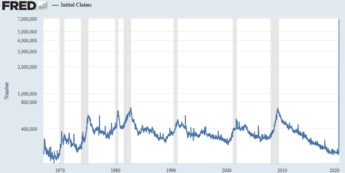I hope everyone has remained safe and healthy during this extraordinary period.
As I write this on Friday morning (April 17), the US equity market is buoyed by further anecdotal evidence — though unsubstantiated by peer-review — that one treatment now in a clinical trial may prove promising as a COVID-19 therapeutic. As glaring and painful as the recent torrent of red may be on any account statement, the S&P 500 is only approximately 14% off the all-time high reached on 2/19/2020.
So, does this represent an inflection point where the “all-clear” signal has been heralded? Far from it, as I will discuss in what follows.
Indeed, I believe investors, understandably thirsty for developments suggestive of a quick market and economic recovery, may be guilty of “confirmation bias.” This myopic tendency is best described as our psychological preference for information that validates our pre-existing beliefs while ignoring disconcerting evidence to the contrary. At present, the investing public appears to be betting dislocations arising from the pandemic will be short-lived, and then using the powerful rally from the March 23 lows to confirm the cheerful hypothesis.
Is this optimism misplaced? Not entirely.
To be certain, the market was prevented from an unrestrained free-fall by three interim developments: 1) the Federal Reserve’s decision to place the weight of its balance sheet on minimizing damage to the country’s credit system; 2) Congress’ passage of the over $2 trillion relief bill, with more on the horizon; and, 3) signs that infection rates may have peaked for now in coastal states where the outbreak ravaged first.
Nevertheless, there is a known set of unknowns which may not have been fully discounted by the market. Most notably, in the short-term:
1) Dismal Unemployment Picture— According to the log-scaled chart (below) compiled from data kept by the St. Louis Federal Reserve, a record 5.245 million Americans filed first-time claims for unemployment insurance as of 4/11/2020 (dark blue line on right), bringing the crisis total to just over 22 million (13% of total US labor force) and nearly wiping out all the job gains since the Great Recession. The weekly unemployment claims figure is one of the few useful coincident indicators permitting a snapshot of the present economic condition.
Historically, spikes in unemployment claims have been accompanied by recessionary periods of varying lengths (light grey shaded areas). According to the National Bureau of Economic Research, the most painless recession lasted 6 months in 1980, with an average of almost 1 year in the last 11 business cycles since 1945. Given the depth of job displacement already evident, it is difficult to envision this recession will be a fleeting mirage. Even under the best case scenario of an accelerated resumption of economic activities in the second half of this year due to pent-up demand, the financial damage already wrought upon the balance sheets of many US households, those representing 70% of the economy, will likely temper and alter consumptive behavior and impact confidence in 2020 and beyond.

Source: Federal Reserve Bank of St. Louis, Retrieved 4/16/2020 at https://fred.stlouisfed.org/series/ICSA
2) Full Extent of Economic Damage— Economists at the New York Federal Reserve have recently developed a new Weekly Economic Index, designed to capture factors influencing GDP trends. The WEI is currently -11.04 percent for the week ending April 11 and -8.42 percent for April 04; for reference, the WEI stood at 1.58 percent for the week ending February 29.
This reading of -11% means that if current weekly conditions persisted for an entire quarter, the Index would expect, on average, a negative 11 percent GDP growth relative to a year prior. While economic conditions are never static, the speed of economic deceleration in recent weeks is irrefutable and particularly alarming, especially in light of uncertainties vis-à-vis the lifting of lockdowns to varying degrees in different parts of the country.
3) Inevitable Force of History— Like many Wall Street truisms acting as security blankets for some, it has been often repeated that no two market cycles are ever the same and that things will be different this time around. Such utter ignorance of history is unwarranted, though, because history serves as a useful check on our expectations for the future as well as provides some framework of analysis.
Since 1926, the average bear market lasted 1.3 years, with three months being the shortest, according to First Trust Portfolios. Moreover, the peak-to-trough declines in the dot.com bubble and the Great Recession were 49.1% and 56.4%, respectively. As applied to the US equity market, which has recovered strongly over the last month, the current drawdown of only 14% suggests this bear market, which only began in late March, portend additional risks to the downside in next three months, at least.
4) Inestimable Variables in Pandemic— Any assessment of economic fallout is challenging precisely because it is dependent upon factors which remain ill-understood, including the pathway of future outbreaks, efficacy of containment efforts, credible therapeutics for those fallen ill, and development of vaccines to mitigate future waves of infections.
Juxtaposed against this array of public health exigencies lies the no less urgent existential need to reopen the economy, especially critical for those temporarily furloughed and their small-and-medium business employers. The astute finesse required to manage this tension cannot be overstated as any reopening guidelines based upon flawed modeling will likely result in further delay in returning to “business as usual.”
Given these near-term challenges, the resolution of which remains uncertain, any unbridled exuberance tied to the ongoing market upswing is unjustified. If nothing else, current market volatilities remind us of the importance of assessing and understanding risks we already assume in our portfolios. For most investors, caution and risk mitigation should remain the overarching themes of any such critical examinations.
Take extra good care of yourself and each other!
